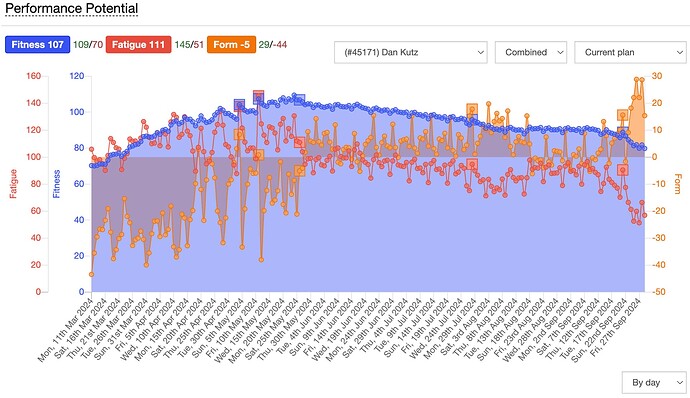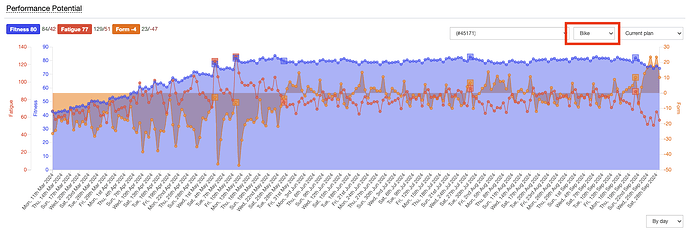Hello, I’d like to better understand the Performance Potential Chart. I have a new coaching client whose PPC looks like this:
How does the PPC determine fitness and why does his chart decrease?
Is it likely that his performance will continue to increase with more time with Athletica?
Do we need to increase the training duration for an increase to happen?
There was this thread about the training duration and this thread about the PPC.
I’d like to be able to better explain the PPC and its long-term view to the athlete.
Thanks!
Very good question @SimpleEnduranceCoach !
From Athletica perspective, we are looking at a “combined” performance potential, which might include different activities (e.g. run, row). If we look at the “Bike” performance potential, this is actually what Athletica is trying to elevate and maintain. This is because this athlete is following a Cycling XC MTB, therefore the focus is on bike potential.
If in the past running sessions or S&C sessions were included, remember that the perfromance potential is computed with what is already scheduled. For example, if no additional running sessions are scheduled, the “combined” (run + bike) performance potential will decrease, but the “bike” performance potential will keep increasing and eventually level.
Make sense?
2 Likes
Thanks Andrea. Yes, that makes sense. And to make his bike performance increase, we would need to increase his weekly hours?
Thanks.
This is debatable @SimpleEnduranceCoach, as “performance” and “fitness” can be quite different, as you know very well.
Regarding the performance potential chart, what you see is the chronic increase in fitness due to the progressive increase in training load. However, translating this directly into “performance” might not be correct. I’ll give you a simple reason, though there are many: you can achieve the same load with infinite combinations of intensity and duration. Thus, you might keep your training load stable while improving performance because you become better at performing, triggering those slow/delayed/central adaptations that require time to kick in.
At a very high level, yes, if two athletes have quite different training load regimens, there is a high probability that they can cope with different training volumes, and hence they have different performance potentials. Athletes in different categories are known for being able to sustain different training loads.
But when we are speaking about the same athlete from season to season, or during the same season, even stable fitness, if sustained for a prolonged period, can lead to an increase in performance. Indeed, when the load is well-tuned, there might be some spare time that can be devoted to flexibility, proprioception, respiratory muscles, mindset, diet, etc.
Sorry if I’m stating the obvious; I bet you already know everything I just wrote. The short version would be: yes, increasing the volume of the training plan will lead to a steady increase in “fitness”. But be aware that this might not necessarily be synonymous with “performance”.
Please let me know if this is not clear or if this is not what you are seeing in your everyday practice. We are interested.
7 Likes
This is a great answer, that makes a lot of sense. I appreciate your time, Andrea! Athletica’s goal is to improve the fitness of an athlete as much as possible, given training time constraints.
2 Likes

